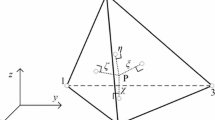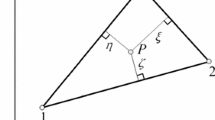Abstract
A solid tetrahedral finite element employing the absolute nodal coordinate formulation (ANCF) is presented. In the ANCF, the mass matrix and vector of the generalized gravity forces used in the equations of motion are constant, whereas the vector of the elastic forces is highly nonlinear. The proposed solid element uses translations of nodes as sets of nodal coordinates. The tetrahedral shape of the element makes it suitable for modeling structures with complex shapes, and the small number of the degrees of freedom enables good performance and versatile application to problems of structural dynamics. The accuracy and convergence of the element were investigated using statics and dynamics benchmarks and a practical industry application.












Similar content being viewed by others
References
Zienkiewicz, O.C., Taylor, R.L.: The Finite Element Method, Solid and Fluid Mechanics, vol. 2, 4th edn. McGraw–Hill Book, New York (1991)
Shabana, A.A.: Dynamics of Multibody Systems, 3rd edn. Cambridge University Press, New York (2005)
Shabana, A.A.: Definition of the slopes and the finite element absolute nodal coordinate formulation. Multibody Syst. Dyn. 1(3), 339–348 (1997)
Gerstmayr, J., Shabana, A.: Analysis of thin beams and cables using the absolute nodal coordinate formulation. Nonlinear Dyn. 45(1–2), 109–130 (2006)
Wu, G., He, X., Pai, F.: Geometrically exact 3D beam element for arbitrary large rigid-elastic deformation analysis of aerospace structures. Finite Elem. Anal. Des. 47(4), 402–412 (2011)
Yoo, W.-S., Dmitrochenko, O., Park, S.-J., Lim, O.-K.: A new thin spatial beam element using the absolute nodal coordinates: application to a rotating strip. Mech. Based Des. Struct. Mach. 33(3–4), 399–422 (2005)
Dmitrochenko, O.: Finite elements using absolute nodal coordinates for large-deformation flexible multibody dynamics. J. Comput. Appl. Math. 215(2), 368–377 (2008)
Gerstmayr, J., Matikainen, M., Mikkola, A.: A geometrically exact beam element based on the absolute nodal coordinate formulation. Multibody Syst. Dyn. 20(4), 359–384 (2008)
Nachbagauer, K., Gruber, P., Vetyukov, Y., Gerstmayr, J.: A spatial thin beam finite element based on the absolute nodal coordinate formulation without singularities. In: Proceedings of the ASME 2011 Int. Design Eng. Techn. Conf. & Computers and Information in Eng. Conf. IDETC/CIE 201. Washington, DC, USA, 2011.08.28–31. (2011) by ASME
Nachbagauer, K., Gruber, P., Vetyukov, Y., Gerstmayr, J.: Structural and continuum mechanics approaches for a 3D shear deformable ANCF beam finite element: application to static and linearized dynamic examples. J. Comput. Nonlinear Dyn. 8(2), 021004 (2012)
Nachbagauer, K., Pechstein, A.S., Irschik, H., Gerstmayr, J.: A new locking-free formulation for planar, shear deformable, linear and quadratic beam finite elements based on the absolute nodal coordinate formulation. Multibody Syst. Dyn. 26(3), 245–263 (2011)
Schwab, A. L., Meijaard, J. P.: Comparison of three-dimensional flexible beam elements for dynamic analysis: classical finite element formulation and absolute nodal coordinate formulation. J. Comput. Nonlinear Dyn. 5(1), 011010 (2009). doi:10.1115/1.4000320
Bauchau, O., Han, S., Mikkola, A., Matikainen, M.: Comparison of the absolute nodal coordinate and geometrically exact formulations for beams. Multibody Syst. Dyn. 32, 67–85 (2014)
Vohar, B., Kegl, M., Ren, Z.: Implementation of an ANCF beam finite element for dynamic response optimization of elastic manipulators. Eng. Optim. 40(12), 1137–1150 (2008)
Matikainen, M., Schwab, A., Mikkola, A.: Comparison of two moderately thick plate elements based on the absolute nodal coordinate formulation. Multibody dynamics 2009, ECCOMAS Thematic Conference. In: Arczewski, K., Frączek, J., Wojtyra M. (eds.), Warsaw, Poland, 29 June–2 July (2009)
Dmitrochenko, O., Pogorelov, D.: Generalization of plate finite elements for absolute nodal coordinate formulation. Multibody Syst. Dyn. 10(1), 17–43 (2003)
Dmitrochenko, O., Mikkola, A.: Two simple triangular plate elements based on the absolute nodal coordinate formulation. J. Comput. Nonlinear Dyn. 3(4), 041012 (2008)
Dmitrochenko, O., Mikkola, A.: Shear correction of a thin plate element in absolute nodal coordinates. In: Proc. of 8th World Congr. On Comp. Mech. (WCCMS) and 5th Eur. Congr. on Computat. Meth. in Appl. Set and Eng. (ECCOMAS 2008). 2008.06.30–04. Venice. Italy. ISBN 978–84–96736–55–9. p. 127
Dmitrochenko, O., Mikkola, A.: Shear correction for thin plate finite elements based on the absolute nodal coordinate formulation. In: Proceedings of ASME 2009 IDETC/CIE 2009. 2009.08.30–02. San Diego. California. USA. 1–9
Hyldahl, P., Mikkola, A., Balling, O.: A thin plate element based on the combined arbitrary Lagrange–Euler and absolute nodal coordinate formulations. In: Proceedings of the Institution of Mechanical Engineers, Part K: Journal of Multi-body Dynamics, (2013)
Shi, W., Park, H., Chung, C., Baek, J., Kim, Y., Kim, C.W.: Load analysis and comparison of different jacket foundations. Renew. Energy 54, 201–210 (2013)
Langerholc, M., Slavič, J., Boltežar, M.: A thick anisotropic plate element in the framework of an absolute nodal coordinate formulation. Nonlinear Dyn. 73(1–2), 183–198 (2013)
Olshevskiy, A., Dmitrochenko, O., Dai, M.D., Kim, C.W.: The simplest 3-, 6-and 8-noded fully-parameterized ANCF plate elements using only transverse slopes. Multibody Syst. Dyn. 34(1), 23–51 (2015)
Olshevskiy, A., Dmitrochenko, O., Lee, S.S., Kim, C.W.: A triangular plate element 2343 using second-order absolute-nodal-coordinate slopes: numerical computation of shape functions. Nonlinear Dyn. 74(3), 769–781 (2013)
Yamashita, H., et al.: Continuum mechanics based bi-linear shear deformable shell element using absolute nodal coordinate formulation. J. Comput. Nonlinear Dyn. (2014). doi:10.1115/1.4028657
Gerstmayr, J., Sugiyama, H., Mikkola, A.M.: Review on the absolute nodal coordinate formulation for large deformation analysis of multibody systems. J. Comput. Nonlinear Dyn. 8, 031016 (2013). doi:10.1115/1.4023487
Gallagher, R.H.: Finite element analysis: Fundamentals. Prentice-Hall Civil Engineering and Engineering Mechanics Series. Prentice-Hall, Englewood Cliffs (1975)
Dmitrochenko, O., Mikkola, A.: Extended digital nomenclature code for description of complex finite elements and generation of new elements. Mecha. Based Des. Struct. Mach. Int. J. 39(2), 229–252 (2011)
Kübler, L., Eberhard, P., Geisler, J.: Flexible multibody systems with large deformations and nonlinear structural damping using absolute nodal coordinates. Nonlinear Dyn. 34, 31–52 (2003)
Olshevskiy, A., Dmitrochenko, O., Kim, C.W.: Three-dimensional solid brick element using slopes in the absolute nodal coordinate formulation. J. Comput. Nonlinear Dyn. 9, 021001 (2014)
Wei, C., Shabana, A.: A total Lagrangian finite element approach for computational fluid dynamics based on absolute nodal coordinates formulation. In: The 3rd Joint International Conference on Multibody System Dynamics, The 7th Asian Conference on Multibody Dynamics. June 30-July 3, 2014, BEXCO, Busan, Korea
Argyris, J.H., Fried, I., Sharpf, D.W.: The TET 20 and TEA8 elements for the matrix displacement method. Aeronaut. J. R. Aeronaut. Soc. 72, 618–623 (1968)
Lo, S.H., Ling, C.: Improvement on the 10-node tetrahedral element for three-dimensional problems. Comput. Methods Appl. Mech. Eng. 189, 961–974 (2000)
Taylor, R.L.: A Mixed-Enhanced Formulation for Tetrahedral Finite Elements. Report No. UCB/SEMM-99/02
ANSYS, Inc., ANSYS\(\textregistered \) Academic research, release 11.0, Help system, coupled field analysis guide, (2008)
Olshevskiy, A., Dmitrochenko, O., Kim, C.W.: Three- and four-noded planar elements using absolute nodal coordinate formulation. Multibody Syst. Dyn. 29(3), 255–269 (2013)
Dufva, K., Shabana, A.: Analysis of thin plate structures using the absolute nodal coordinate formulation. In: Proc. of the Inst. of Mech. Eng., Part K: J. of Multibody Dynamics. December 1 1(219), 345–355 (2005)
Kehlin, B.H., Boldyriev, O.P., Ivanov, O.V., Stupin, D.O.: Improving the efficiency of combined friction of shock-absorbing devices on the basis of the PMK-110A. Science and Transport Progress. Bull. Dnipropetrovsk Natl. Univ. Railw. Transp. 5, 85–95 (2004)
Acknowledgements
This research was supported by Agency for Defense Development under the contract UD150022GD, National Research Foundation of Korea(NRF) grant 2016R1A2B2015794, and the 2016 KU Brain Pool of Konkuk University.
Author information
Authors and Affiliations
Corresponding author
Rights and permissions
About this article
Cite this article
Olshevskiy, A., Dmitrochenko, O., Yang, HI. et al. Absolute nodal coordinate formulation of tetrahedral solid element. Nonlinear Dyn 88, 2457–2471 (2017). https://doi.org/10.1007/s11071-017-3389-1
Received:
Accepted:
Published:
Issue Date:
DOI: https://doi.org/10.1007/s11071-017-3389-1




